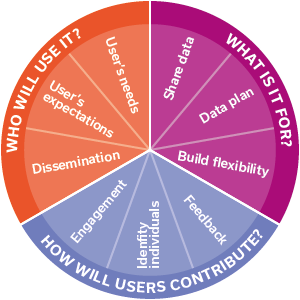Model & data guide
As part of our work exploring how to increase the uptake and use of decision-support models, Katie Jenkins has developed guidance on how to ensure consideration of models and data is included throughout a research project.
Fundamental principles you should consider throughout the process:
- Be open about what went wrong and what you did about it.
- Outreach shouldn’t be an afterthought, but make sure it is costed and funded.
- Download our in-depth model & data guide (pdf, 5.2 MB)
1 Project proposal
- Identify stakeholders who would use your data or model.
- Explore with these stakeholders what sort of data or models they currently use.
- Explore what data or models are currently in use and build on existing work, don’t repeat it.
- Consider involving an industry champion to implement the model in their organisation.
- Work with stakeholders to develop strategies that are able to cope with a range of data requirements.
- Develop strategies for dealing with disparate or conflicting user needs.
- Establish agreements in principle for use of any private / public stakeholder data.
- Investigate resources needed for on-going data management and to ensure data remains accessible / usable after the project ends.
- Define what skills are required to transform research outputs into material suitable for users.
- Budget for phases of user-testing throughout the project.
2 Project management
- Will staff need additional training? e.g. data management, managing stakeholders.
- Assign tasks to specific people.
- Investigate details of stakeholder data requirements and working processes.
- Engage with specialist personnel from stakeholder organisations who work with data or models.
- Find out if the way stakeholders and researchers use data is compatible.
- Discuss preferred data formats with stakeholders and third party data suppliers before research begins.
- Explore output and dissemination channels, as well as potential constraints.
- Expectations and requests may change, so be prepared to be flexible.
- Help end-users communicate with researchers and vice versa.
- Manage stakeholder expectations and be aware of stakeholder fatigue.
- Store data in a standardised (open source) repository throughout the project.
- Design and implement a monitoring and evaluation programme to track data usage.
- Develop a data dissemination and legacy plan that is regularly updated.
3 Research
- Keep the needs of stakeholders in mind while research is underway.
- Re-evaluate stakeholder needs regularly.
- Allow stakeholders and practitioners access to provisional data so they can provide feedback.
- Use a range of engagement approaches, for example, participatory workshops.
- Provide progress reports to keep stakeholders informed.
- Look beyond your initial goals and stakeholders – could your data be useful for other users? Is it compatible with other systems?
- Keep evaluating your output plans to ensure there are no barriers to implementation.
4 Results & analysis
- Provide researchers with training on how to format outputs for different audiences.
- Continue discussions with users and personnel on findings, outputs, formats and uses.
- Continue evaluation and analysis of outputs and how they fit with stakeholder needs.
- Explore tools and mechanisms to support model and data management and sharing.
- Communicate the scale and limitations of the model to end-users.
- Researchers should make a note of any data format or model functionality they have proposed but could not use. This allows them to recommend improvements to stakeholders’ systems, and also to revisit the output later should external systems be compatible in the future.
5 What next?
- Develop clear documentation on outputs, interpretation and limits.
- Take advantage of stakeholders’ expertise to understand the practical uses of the data or model.
- Explore options for creating a less technical version of the model for a wider audience to use.
- Investigate other funding sources to develop the model further into a usable tool, for example, Impact Acceleration Account (IAA) or institutional grants.
6 Final stages
- Presentation and visualisation of data and tools should be clear, and geared to specific users and their needs.
- Focus on the usability of outputs as well as usefulness.
- Focus on how stakeholders could use the model, and what that means in their particular sector.
- Enable the industry champion to take ownership of the model & share widely, if appropriate.
- Tailor final engagement activities and locations to suit the stakeholders, for example, as part of industry events or where web-based activities are most effective.
- Explore collaborative grants to enhance the impact and usability of outputs, for example, working with web developers or other academics with different skill sets.
- Keep reviewing and monitoring after launch.
- Collect feedback on the usability of the data and model.
- Are the actual users those initially intended? Is the data discoverable and usable by new stakeholders?
- Consider how the data can be applied in future projects.


